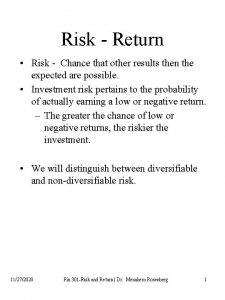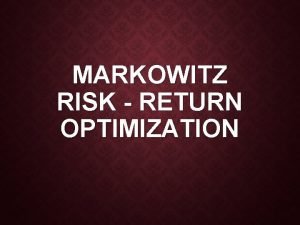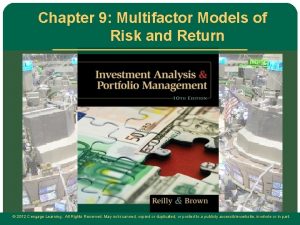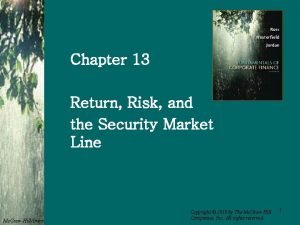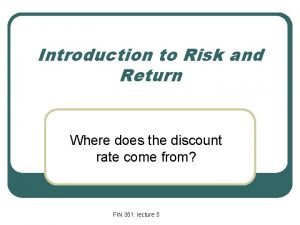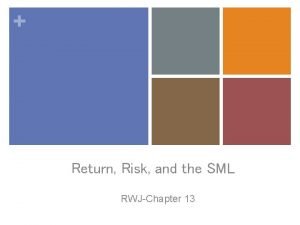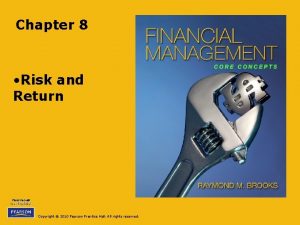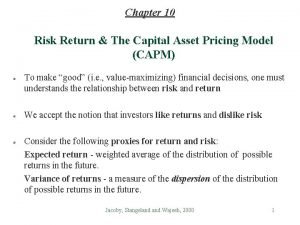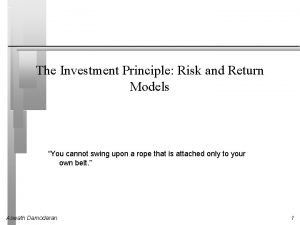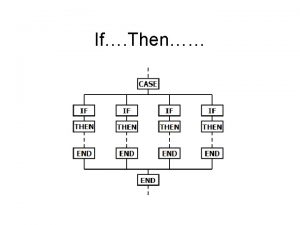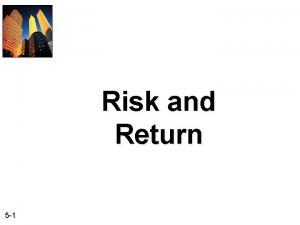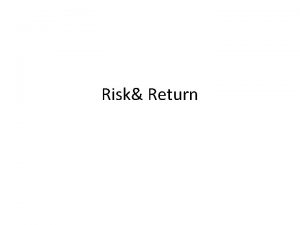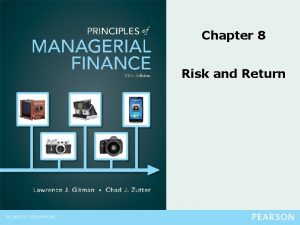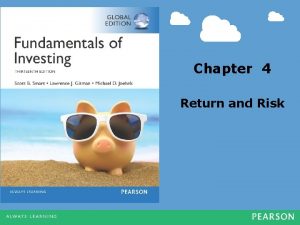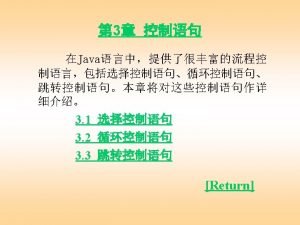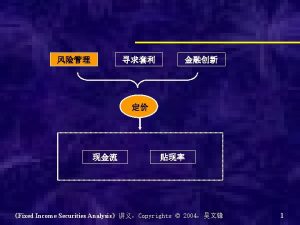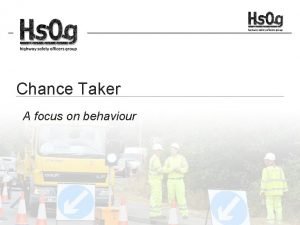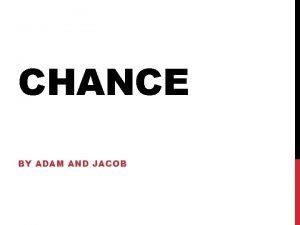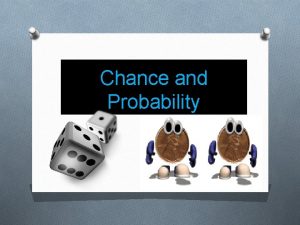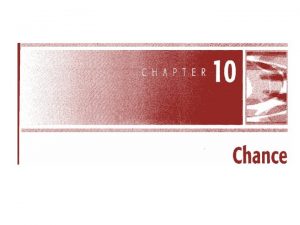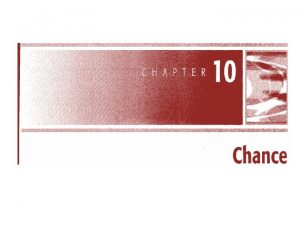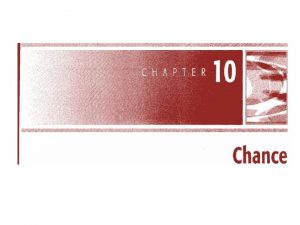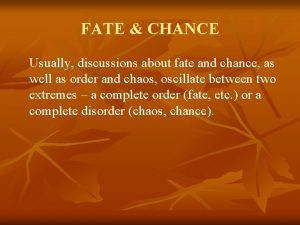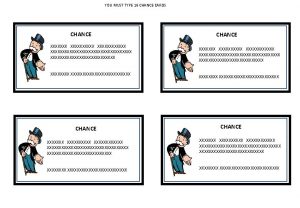Risk Return Risk Chance that other results then























- Slides: 23

Risk - Return • Risk - Chance that other results then the expected are possible. • Investment risk pertains to the probability of actually earning a low or negative return. – The greater the chance of low or negative returns, the riskier the investment. • We will distinguish between diversifiable and non-diversifiable risk. 11/27/2020 Fin 301 -Risk and Return | Dr. Menahem Rosenberg 1

Risk Measure • Probability - the chance (measured in fraction or percentage) that a specific event will occur • Probability distribution - A listing of all possible events and their associated probabilities. 11/27/2020 Fin 301 -Risk and Return | Dr. Menahem Rosenberg 2

Probability Distributions of Returns • Assume that there are two stocks available, LORIS Inc and HIRIS Corp and each responds to the state of the economy according to the following table 11/27/2020 Fin 301 -Risk and Return | Dr. Menahem Rosenberg 3

Probability Distributions of Returns of LORIS and HIRIS 0. 5 Probability 0. 4 0. 3 0. 2 0. 1 0 40% LORIS 30% 20% Return 11/27/2020 10% HIRIS 0% Fin 301 -Risk and Return | Dr. Menahem Rosenberg -10% 4

Expected Return • Expected Return- Weighted Average return, using event probabilities as weights. • • • Both companies have the same expected return, but there is considerably more risk associated with HIRIS 11/27/2020 Fin 301 -Risk and Return | Dr. Menahem Rosenberg 5

Standard Deviation • Risk is measured with the Standard Deviation. 11/27/2020 Fin 301 -Risk and Return | Dr. Menahem Rosenberg 6

Observation • The expected returns of LORIS and HIRIS happen to be equal, but the volatility, or standard deviation, of HIRIS is higher than that of LORIS’s • However, we would expect share prices to follow a continuous distribution, rather than the discrete distribution illustrated 11/27/2020 Fin 301 -Risk and Return | Dr. Menahem Rosenberg 7

Portfolio • Let: – $P total portfolio $ value – $A , $B - Value of investment in stock A and B respectively. • Assume all the portfolio is allocated between A or B, so that P = A+ B Let : w. A, w. B, be the proportion invested in stock A and B respectively We get that 1 = w. A + w. B and w. B = 1 - w. A Let: r. P, r. A, r. B be the assets returns. Then r P = w A r A+ w B r. P = w. A r. A+ (1 - w. A ) r. B 11/27/2020 Fin 301 -Risk and Return | Dr. Menahem Rosenberg 8

Portfolio • Combine above LORIS and HIRIS stocks into a portfolio: 11/27/2020 Fin 301 -Risk and Return | Dr. Menahem Rosenberg 9

Portfolio with Assets • A portfolio with two assets, 1 and 2. • Using the past to project the future: • We can use historical return to evaluate the mean return and its standard deviation, though we should remains on watch, whether the past really projects the future. 11/27/2020 Fin 301 -Risk and Return | Dr. Menahem Rosenberg 10

Portfolio with two Assets • Use 30 month stock close prices adjusted for dividend and other distribution: 11/27/2020 Fin 301 -Risk and Return | Dr. Menahem Rosenberg 11

Portfolio with two Assets • The previous data allows us to compute GE and XON characteristic properties: • Using this data and previous formula we can compute portfolio return and standard deviation with different weights for GE and XON 11/27/2020 Fin 301 -Risk and Return | Dr. Menahem Rosenberg 12

Portfolio Line • We can plot the portfolio return against the portfolio’s variance: 11/27/2020 Fin 301 -Risk and Return | Dr. Menahem Rosenberg 13

Asset Risk • we observed that there were two kinds of risk – diversifiable or individual risk – Non-diversifiable or market risk • We also observed that in the limit as the number of securities becomes very large, the portfolio risk approaches the average covariance, which can be considered Nondiversifiable or systematic risk, . 11/27/2020 Fin 301 -Risk and Return | Dr. Menahem Rosenberg 14

• Stand-alone vs Market Risk • We saw that there was individual-stand alone risk and market risk Assume that each equity’s return is the composition of two random variables: – one associated with the market’s return – one associated with the companyspecific return Market risk is that part of a security’s standalone risk that cannot be eliminated by diversification, and is measured by beta. Firm-specific risk is that part of a security’s stand-alone risk that can be eliminated by proper diversification (2) Stand Alone Risk = Market risk +Firm-specific risk 11/27/2020 Fin 301 -Risk and Return | Dr. Menahem Rosenberg 15

CAPM • The stock compensated risk is measured as the risk it adds to a well diversified portfolio: – Case 1 : it does not add any additional risk, its return changes are the same as the markets return – Case 2: it adds risk to the portfolio, its return relative to the market volatility is higher. – Case 3: it reduces the portfolio risk, its return relative to the market volatility is lower. • CAPM will compare and determine risky assets return premium (risk premium) - their return above the risk free asset return. 11/27/2020 Fin 301 -Risk and Return | Dr. Menahem Rosenberg 16

CAPM • ri , si Security i required return and standard deviation • rm sm Market return and standard deviation • rf risk free return • Recall portfolio variance: • Or using the correlation coefficient: • The relative magnitude of the covariance term will determine the above cases 11/27/2020 Fin 301 -Risk and Return | Dr. Menahem Rosenberg 17

CAPM • The Covariance relative measure is beta: – Case 1 - the results in a b =1. 0, and the stock should have the same risk premium as the market risk premium. – Case 2 – b >1. 0 When added to the portfolio will increase the portfolio risk, therefore must add a bigger than the market risk premium. – Case 3 – b < 1. 0 When added to the portfolio will decrease the portfolio risk, therefore must add a smaller than the market risk premium. 11/27/2020 Fin 301 -Risk and Return | Dr. Menahem Rosenberg 18

Comment • Beta measures a stock’s market risk. It shows a stock’s volatility relative to the market • Beta shows how risky a stock is if the stock is held in a well-diversified portfolio. – CAPM explains the difference between the riskless interest rate and the expected rate of return on the market portfolio, but not their absolute levels – The absolute level of the equilibrium expected rate of return on the market portfolio is determined by such factors as – expected productivity – household inter-temporal preferences for consumption 11/27/2020 Fin 301 -Risk and Return | Dr. Menahem Rosenberg 19

CAPM • According the CAPM, in equilibrium, the risk premium on any asset is equal the product of – b (or ‘Beta’) – the risk premium on the market portfolio • The model states that: 11/27/2020 Fin 301 -Risk and Return | Dr. Menahem Rosenberg 20

Security Market Line – The plot of a security returns(or sometimes security risk premiums) against security beta is the Security Market Line, • Note that the slope of the security market line is the market premium • By CAPM theory, all securities must fall precisely on the SML (hence its name) 11/27/2020 Fin 301 -Risk and Return | Dr. Menahem Rosenberg 21

Security Market Line SML: ri = rf + (rm – rf ) bi ri SML rm rf . T-bills 0 11/27/2020 1 Fin 301 -Risk and Return | Dr. Menahem Rosenberg bi 22

Portfolio beta • Assume a portfolio p made of N assets with return ri that follow the CAPM relationship. The portfolio return is: • Define 11/27/2020 Fin 301 -Risk and Return | Dr. Menahem Rosenberg 23
 Phân độ lown
Phân độ lown Block nhĩ thất độ 2 mobitz 1
Block nhĩ thất độ 2 mobitz 1 Thơ thất ngôn tứ tuyệt đường luật
Thơ thất ngôn tứ tuyệt đường luật Thơ thất ngôn tứ tuyệt đường luật
Thơ thất ngôn tứ tuyệt đường luật Chiến lược kinh doanh quốc tế của walmart
Chiến lược kinh doanh quốc tế của walmart Tìm vết của mặt phẳng
Tìm vết của mặt phẳng Hãy nói thật ít để làm được nhiều
Hãy nói thật ít để làm được nhiều Tôn thất thuyết là ai
Tôn thất thuyết là ai Gây tê cơ vuông thắt lưng
Gây tê cơ vuông thắt lưng Sau thất bại ở hồ điển triệt
Sau thất bại ở hồ điển triệt Liquidity measures
Liquidity measures What is sweetened then soured boiled then cooled
What is sweetened then soured boiled then cooled Risk and return
Risk and return Risk and return
Risk and return Markowitz model of risk return optimization
Markowitz model of risk return optimization Risk and return
Risk and return Multifactor model of risk and return
Multifactor model of risk and return Financial management chapter 8 risk and return
Financial management chapter 8 risk and return Chapter 13 return risk and the security market line
Chapter 13 return risk and the security market line Introduction to risk and return
Introduction to risk and return Risk and return
Risk and return Chapter 8 risk and rates of return problem solutions
Chapter 8 risk and rates of return problem solutions Calculate expected portfolio return
Calculate expected portfolio return Risk return principle
Risk return principle












